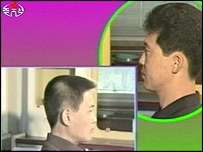Let's trim our hair in accordance with the socialist lifestyle
| Let's trim our hair in accordance with the socialist lifestyle | |
| Chosŏn'gŭl | 사회주의적생활양식에 맞게 머리단장을 하자 |
|---|---|
| Hancha | 社會主義的生活樣式에 맞게 머리丹粧을 하자 |
| Revised Romanization | Sahoe juuijeok saenghwal yangsige matge meori danjangeul haja |
| McCune–Reischauer | Sahoe chuŭijŏk saenghwal yangsige matke mŏri tanjangŭl haja |

Let's trim our hair in accordance with the socialist lifestyle[1] (alternatively translated as Let us trim our hair in accordance with Socialist lifestyle)[2] is a television program that was part of a North Korean government propaganda campaign promulgating grooming and dress standards in 2004–2005.[2]
It was broadcast on state-run Korean Central Television in the capital of Pyongyang and clips from the program were later rebroadcast on the British channel BBC One. The program claimed that hair length can affect human intelligence, in part because of the deprivation to the rest of the body of nutrients required for hair to grow.[1] However, although some researchers have proposed that brain and hair are in competition from an evolutionary standpoint,[3] cutting hair has no influence on its rate of growth.[4] It was part of a longstanding North Korean government restriction campaign against haircuts and fashions deemed at odds with "Socialist values".[2]
North Korea's fashion restrictions
Such dress and hair standards have long been a fixture of North Korean society. Kim Jong-Il was known for his so-called "Speed Battle Cut" crew cut when he first came to prominence in the early 1980s, though he later reverted to the short sided bouffant favored by his father.[5] After Kim Jong-Il succeeded his father, some of the state's restrictions on Western fashion were relaxed. Women were allowed permanent waves, men could grow slightly longer hair, and even public dancing was allowed.[6] Despite such slight concessions during the early years of Kim Jong-Il's rule, obvious emblems of Western fashion such as jeans continued to be entirely banned, and long hair on men could lead to arrest and forced haircuts.[7]
According to the North Korean daily Rodong Sinmun (Worker's Newspaper), the leadership was fighting a guerrilla war against the possible incursion of capitalism into the sphere of personal appearance. Along with long hair, untidy shoes were identified as the epitome of Western culture which, by imitation, would lead the country to ruin.[8]
Television series
The series began in 2004 as part of the regular television program Common Sense. In the autumn of that year, a larger media campaign (print and radio as well as television)[1] began promoting proper attire and neat appearances for men. The show encouraged short hairstyles, such as the flat-top crew cut, middle hairstyle, low hairstyle, and high hairstyle. It said that hair should be kept between 1 and 5 cm (0.4 and 2.0 in) in length, and recommended haircuts for men every 15 days. The country's official hairstyles did allow men over 50 years old to grow their upper hair up to 7 cm (2.8 in) long, to disguise balding.[2]
An initial five-part series of the show featured officially endorsed haircut styles, while a later series went a step further by showing certain men as examples of how not to trim one's hair. With each example, the show conveyed the person's name and where they lived (or worked) via subtitles and/or voice.[1] For example, in one episode (shown in January 2005) a North Korean citizen named Mr. Ko Gwang Hyun, whose unkempt hair covered his ears, was shown as a negative role model, with the voiceover commentary: "We cannot help questioning the cultural taste of this comrade, who is incapable of feeling ashamed of his hair style. Can we expect a man with this disheveled mind-set to perform his duty well?"[9]
In the North Korean capital city of Pyongyang, Western news articles reported that a hidden camera was placed to catch citizens with improper hairstyles. This was part of a television programme broadcast at the same time as Let's Trim Our Hair in Accordance with the Socialist Lifestyle. The offenders would then be interviewed by the presenter and asked to explain themselves. Their name, address and workplace would be announced to deter others from being embarrassed and ostracized.[10]
See also
References
- 1 2 3 4 "N Korea wages war on long hair". BBC News. 2005-01-08. Retrieved 2009-03-14.
- ↑ Dror and Hopp (2014-09-27). "Hair for brain trade-off, a metabolic bypass for encephalization" (PDF). Springer Verlag. Retrieved 2016-02-09.
- ↑ "Hair Growth Tips: Do Regular Trims Really Make It Grow Faster?". Huffington Post. 2012-05-07. Retrieved 2016-02-09.
- ↑ Paul French. North Korea: The Paranoid Peninsula: A Modern History. Zed Books (2007) ISBN 1-84277-905-2 p. 15
- ↑ Bradley K. Martin. Under the Loving Care of the Fatherly Leader. Macmillan (2006) ISBN 0-312-32322-0, p. 378
- ↑ French (2007) pp. 15–16
- ↑ Tirthankar Mukherjee (2007-10-04). "Keeping Our Hair On". UB Post. Retrieved 2009-03-14.
- ↑ Sang-Hun Choe (2005-02-01). "It's all about hair as communists wage war". Independent Online (South Africa). Retrieved 2009-03-14.
- ↑ "N. Korea Wages War on Long Hair". BBC News. 2005-01-08. Retrieved 2016-04-17.
External links